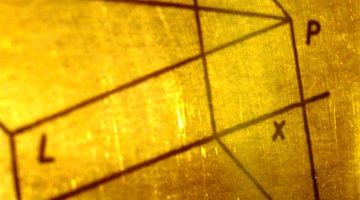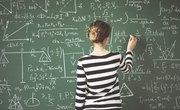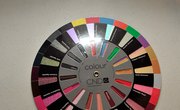Geometry is one of the six mathematical domains addressed by the national Common Core State Standards. By July of 2013, these standards had been adopted by 45 of 50 states and the District of Columbia. Students in grades nine through twelve study Euclidean geometry synthetically, which means without coordinates, and analytically, which means with coordinates. Most geometry units are broken up into six smaller topics: congruence; similarity, right triangles and trigonometry; circles; expressing geometric properties with equations; geometric measurement and dimension; and modeling with geometry.
Euclidean Geometry
Euclidean geometry dates back to the Greek mathematician, Euclid, who lived around 300 BCE. Until the late nineteenth century, all geometry was Euclidean. Euclid is best known for his five postulates, or axioms. According to the Common Core State Standards Initiative, Euclidean geometry is characterized most importantly by the parallel postulate. The parallel postulate asserts that through any given point not on a line there passes exactly one line parallel to that line in the same plane.
Congruence
In learning about congruence, students study and experiment with transformations in the plane. They come to understand congruence in terms of rigid motions and learn how to predict the ways in which a rigid motion will transform a given figure or set of figures. Theorems also play a large role in the study of congruence. As they progress from ninth to twelfth grade, students learn to prove theorems about lines, angles, triangles and parallelograms. Students are also taught to make geometric constructions using a wide variety of hands-on tools and methods.
Similarity, Right Triangles & Trigonometry
Students studying similarity, right triangles and trigonometry are expected to understand similarity in terms of similarity transformations to prove theorems involving similarity, to define trigonometric rations and solve problems involving right triangles and to apply trigonometry to general triangles. In geometry, similarity transformations are actions that change the size or position of a construction without changing its shape. For example, this may mean that a student needs to be able to prove that two triangles are similar in scale, even if one is upside down and dilated to twice the size. Students also learn to apply the Pythagorean theorem and the laws of sines and cosines in appropriate situations.
Circles
High school students studying geometry spend a great deal of time exploring the theorems that apply to circles. Building on their pre-existing knowledge of lines and angles, students continue working with radii, chords, diameters, tangents, and circumferences. The bulk of their time is spent learning to construct the inscribed and circumscribed circles of a triangle and prove properties of angles for a quadrilateral inscribed in a circle. Students are also expected to know how to find arc lengths and areas of sectors in circles.
Expressing Geometric Properties with Equations
Expressing geometric properties with equations primarily focuses on two skills. The first is translating between geometric descriptions and equations for conic sections. In simpler terms, this means learning to derive equations for circles, parabolas, ellipses and hyperbolas from given information. The second skill develops students' abilities to prove simple geometric theorems algebraically. Here the study of geometry asks students to apply their learning from other mathematical domains to the geometric problems.
Geometric Measurement & Dimension
Students studying geometric measurement and dimension take their ability to understand and use formulas a step further as they are called upon to explain the volume formulas for the circumference and area of a circle as well as for the volume of a cylinder, pyramid, cone, sphere and other three dimensional objects. Key to this ability is an understanding of Cavalieri’s principle, which states that solid figures of equal height in which all corresponding cross sections match in length are also equal in volume. Students also expand their abilities to visualize relationships between two-dimensional and three-dimensional objects.
Modeling with Geometry
The final topic in the high school geometry domain is modeling. Modeling makes geometry tangible by bringing it off the paper and into the real world. By the time they are finished studying geometry at the high school level, students are expected to be able to use geometric shapes and their measures and properties to describe objects, to apply concepts of density based on area and volume to modeling situations, and to apply geometric methods to design problems. Students commonly demonstrate their mastery with interdisciplinary projects that incorporate modeling with geometry and authentic problem solving tasks.
Related Articles
References
Writer Bio
A lifetime resident of New York, Christi O'Donnell has been writing about education since 2003. O'Donnell is a dual-certified educator with experience writing curriculum and teaching grades preK through 12. She holds a Bachelors Degree from Sarah Lawrence College and a Masters Degree in education from Mercy College.











